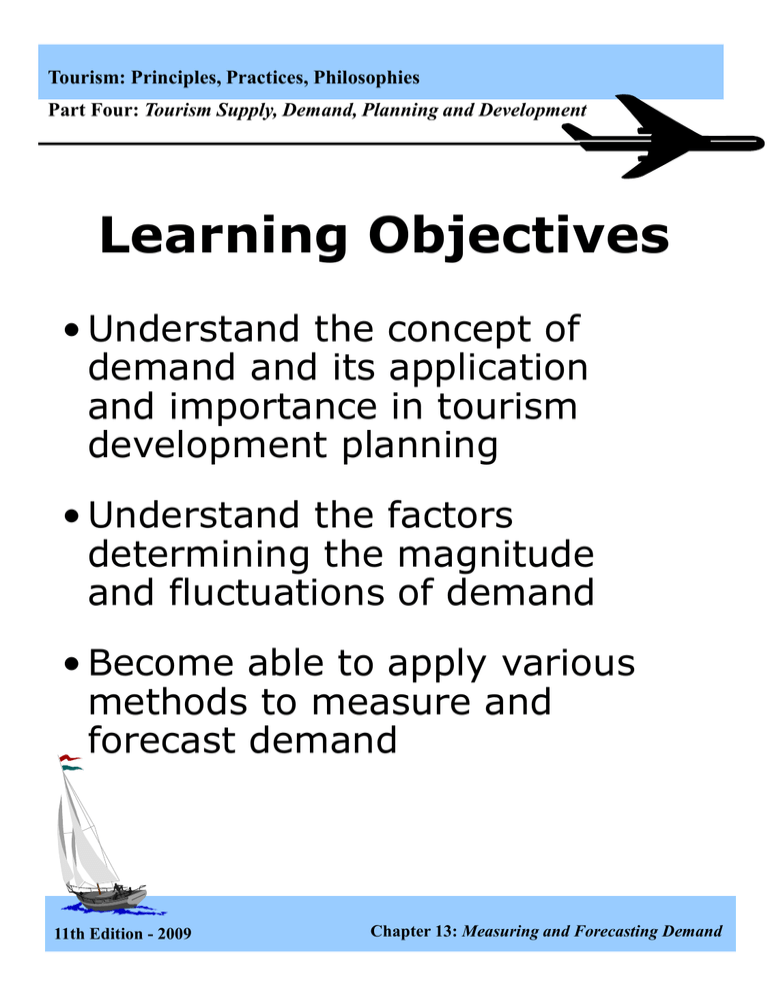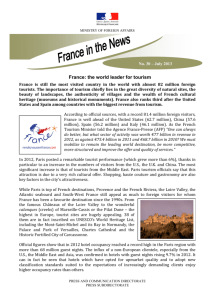Tourism: Principles, Practices, Philosophies Part One
advertisement

Tourism: Principles, Practices, Philosophies Part Four: Tourism Supply, Demand, Planning and Development Learning Objectives • Understand the concept of demand and its application and importance in tourism development planning • Understand the factors determining the magnitude and fluctuations of demand • Become able to apply various methods to measure and forecast demand 11th Edition - 2009 Chapter 13: Measuring and Forecasting Demand Tourism: Principles, Practices, Philosophies Part Four: Tourism Supply, Demand, Planning and Development Vital Demand Data 1. Number of visitors 2. Means of transportation used by visitors to arrive at destination 3. Length of stay and type of accommodations used 4. Amount of money spent by visitors 11th Edition - 2009 Chapter 13: Measuring and Forecasting Demand Tourism: Principles, Practices, Philosophies Part Four: Tourism Supply, Demand, Planning and Development Demand to a Destination Demand for travel to a particular destination is a function of the propensity of the individual to travel and the reciprocal of the resistant of the link between origin and destination areas Demand = f(propensity, resistance) Propensity depends on: Resistance depends on: •Psychographics •Economic distance •Demographics •Cultural distance (socioeconomic status) •Marketing effectiveness •Cost of tourist services •Quality of service •Seasonality 11th Edition - 2009 Chapter 13: Measuring and Forecasting Demand Tourism: Principles, Practices, Philosophies Part Four: Tourism Supply, Demand, Planning and Development Measures of Actual Demand 1. Visitor arrivals Number of people arriving at a destination who stay for 24 hours or longer 2. Visitor - days or - nights = no. of visitors x avg. no. of days or nights at destination 3. Amounts spent = no. of visitor - days or - nights x avg. expenditure per day/night 11th Edition - 2009 Chapter 13: Measuring and Forecasting Demand Tourism: Principles, Practices, Philosophies Part Four: Tourism Supply, Demand, Planning and Development Projection Methodology Several statistical methods or econometric analysis can be used to project demand • Trend analysis method • Simple Regression — Linear least square method • Multiple Regression — Linear least squares method • Computer simulations and models • Executive Judgement (Delphi) method 11th Edition - 2009 Chapter 13: Measuring and Forecasting Demand Tourism: Principles, Practices, Philosophies Part Four: Tourism Supply, Demand, Planning and Development Economic Distance Economic distance relates to the time and cost involved in traveling from the origin to the destination area and back. The higher the economic distance, the higher the resistance for that destination and, consequently, the lower the demand. It follows, conversely, that between any origin and destination point, if the travel time or travel cost can be reduced, demand will increase. Many excellent examples of this are available, such as the introduction of the jet plane in 1959 and the introduction of the wide - bodied jets in the late 1960s. Jet planes first cut travel time between California and Hawaii, for example, from twelve hours to five hours, and demand grew dramatically. A similar surge in demand was experienced with the introduction of the wide - bodied planes for transatlantic flights. The introduction of these planes cut the travel cost by almost 50 percent between the United States and most countries on the European continent. Cultural Distance Cultural distance refers to the extent to which the culture of the area from which the tourist originates differs from the culture of the host region. In general, the greater the cultural distance, the greater will be the resistance. In some cases, however, the relationship might be the opposite. For example, the higher the cultural distance between particular origin and destination areas, the more an allocentric person may wish to travel to that destination, to experience this extreme difference. 11th Edition - 2009 Chapter 13: Measuring and Forecasting Demand © John Wiley & Sons, Inc, 2009




